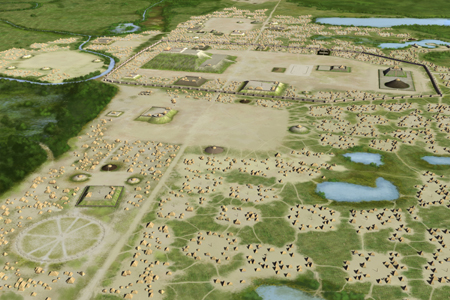
There are so many unusual, interesting, and new things you can find – if you just look around a little bit. And libraries are all about mysteries! So, we are looking at a real-life small mystery each week and bringing some library resources to help add some clarity and some thought.
I grew up in Central Illinois, near-ish to Cahokia. So it was a surprise when I learned that not everyone knew about this community. And of course, it is filled with mystery so we really do not know enough about it – including how it ended.
From the New York Times: “A thousand years ago, a city rose on the banks of the Mississippi River, near what eventually became the city of St. Louis. Sprawling over miles of rich farms, public plazas and earthen mounds, the city — known today as Cahokia — was a thriving hub of immigrants, lavish feasting and religious ceremony. At its peak in the 1100s, Cahokia housed 20,000 people, greater than contemporaneous Paris.
By 1350, Cahokia had largely been abandoned, and why people left the city is one of the greatest mysteries of North American archaeology.”
From the Guardian: “In its prime, about four centuries before Columbus stumbled on to the western hemisphere, Cahokia was a prosperous pre-American city with a population similar to London’s.
Located in southern Illinois, eight miles from present-day St Louis, it was probably the largest North American city north of Mexico at that time. It had been built by the Mississippians, a group of Native Americans who occupied much of the present-day south-eastern United States, from the Mississippi river to the shores of the Atlantic.
Cahokia was a sophisticated and cosmopolitan city for its time. Yet its history is virtually unknown by most Americans and present-day Illinoisans. It is one of many stories that have been bypassed in favour of the shopworn narrative – reinforced in literature and a century of American cinema – of Native Americans as backward and primitive.
“A lot of the world is still relating in terms of cowboys and Indians, and feathers and teepees,” says Thomas Emerson, professor of anthropology at the University of Illinois. “But in AD1000, from the beginning, [a city is] laid on a specific plan. It doesn’t grow into a plan, it starts as a plan. And they created the most massive earthen mound in North America. Where does that come from?”
Its mix of people made Cahokia like an early-day Manhattan, drawing residents from throughout the Mississippian-controlled region: the Natchez, the Pensacola, the Choctaw, the Ofo. Archaeologists conducting strontium tests on the teeth of buried remains have found a third of the population was “not from Cahokia, but somewhere else”, according to Emerson, who is director of the Illinois State Archaeological Survey. “And that’s throughout the entire sequence [of Cahokia’s existence.]”
The Native Americans at Cahokia farmed, traded and hunted. They were also early urban planners, who used astronomical alignments to lay out a low-scale metropolis of 10-20,000 people, featuring a town centre with broad public plazas and key buildings set atop vast, hand-built earthen mounds. The largest of these mounds was 100 feet tall and covered 14 acres – and still exists today.
But rather than developing, like London, into a modern metropolis, Cahokia is more like the fabled lost continent of Atlantis. Having become a major population centre around AD1050, by 1350 it was largely abandoned by its people – and no one is sure why. Neither war, disease, nor European conquest drove Cahokia’s residents from their homes. Indeed, the first white man to reach these lands, Spanish explorer Hernando de Soto, didn’t do so until 1540.”
So – it’s a mystery! This huge, cosmopolitan city just was abandoned.
This could lead to some interesting work in your library.
- Read mystery books
- Read books about archeology
- Read books by and about Native Americans, especially those living hundreds of years ago
- Plan out a town either with colored pencils and paper, or art supplies, or online. Be detailed in what needs to be part of the town, and how it is all organized.
- Talk about other mysteries in archeology
- Write stories about Cahokia: how people lived, what happened
Take this week’s library mystery, and use it to build some programming and displays to suit the needs of your community!
